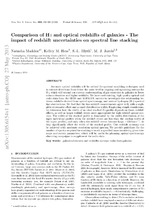| dc.contributor.author | Maddox, Natasha | |
| dc.contributor.author | Hess, Kelley M. | |
| dc.contributor.author | Blyth, S.-L. | |
| dc.contributor.author | Jarvis, Matt | |
| dc.date.accessioned | 2018-02-06T12:28:25Z | |
| dc.date.available | 2018-02-06T12:28:25Z | |
| dc.date.issued | 2013 | |
| dc.identifier.citation | Maddox, N. et al. (2013). Comparison of Hi and optical redshifts of galaxies - The impact of redshift uncertainties on spectral line stacking. Monthly Notices of the Royal Astronomical Society, 433(3): 2613 - 2625 | en_US |
| dc.identifier.issn | 0035-8711 | |
| dc.identifier.uri | http://dx.doi.org/10.1093/mnras/stt934 | |
| dc.identifier.uri | http://hdl.handle.net/10566/3479 | |
| dc.description.abstract | Accurate optical redshifts will be critical for spectral co-adding techniques used
to extract detections from below the noise level in ongoing and upcoming surveys for
Hi, which will extend our current understanding of gas reservoirs in galaxies to lower
column densities and higher redshifts. We have used existing, high quality optical and
radio data from the SDSS and ALFALFA surveys to investigate the relationship be-
tween redshifts derived from optical spectroscopy and neutral hydrogen (Hi) spectral
line observations.We find that the two redshift measurements agree well, with a negli-
gible systematic offset and a small distribution width. Employing simple simulations,
we determine how the width of an ideal stacked Hi profile depends on these redshift
offsets, as well as larger redshift errors more appropriate for high redshift galaxy sur-
veys. The width of the stacked profile is dominated by the width distribution of the
input individual profiles when the redshift errors are less than the median width of
the input profiles, and only when the redshift errors become large, 150 kms−1, do
they significantly affect the width of the stacked profile. This redshift accuracy can
be achieved with moderate resolution optical spectra. We provide guidelines for the
number of spectra required for stacking to reach a specified mass sensitivity, given tele-
scope and survey parameters, which will be useful for planning optical spectroscopy
observing campaigns to supplement the radio data. | en_US |
| dc.language.iso | en | en_US |
| dc.publisher | Oxford University Press | en_US |
| dc.rights | This is the pre-print version (From arXiv:1305.6154 ) of the article published online at: http://dx.doi.org/10.1093/mnras/stt934 | |
| dc.subject | Galaxies | en_US |
| dc.subject | Distances and redshifts | en_US |
| dc.subject | Survey | en_US |
| dc.subject | Radio lines | en_US |
| dc.title | Comparison of Hi and optical redshifts of galaxies - The impact of redshift uncertainties on spectral line stacking | en_US |
| dc.type | Article | en_US |
| dc.privacy.showsubmitter | FALSE | |
| dc.status.ispeerreviewed | TRUE | |
| dc.description.accreditation | Web of Science | |

